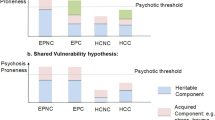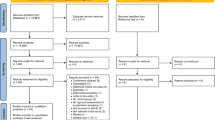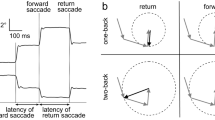Abstract
Altered dopamine neurotransmission and eye movement disturbances have been implicated in the pathogenic process of schizophrenia. So far, molecular genetic studies have shown little association between schizophrenia and polymorphism of any dopamine receptor or transporter genes except for some findings concerning D3 receptor (DRD3) gene. Eye movement disturbances occur in a majority of patients with schizophrenia and in a proportion of their first-degree relatives and they have been suggested as a phenotypic marker in genetic studies of this illness. Here we report an association between the Ser9Gly polymorphism of the DRD3 gene and the intensity of eye movement disturbances (fixation and smooth pursuit) observed in 119 schizophrenic patients and in 94 unrelated healthy control subjects. In schizophrenic patients, the mean intensity of both kinds of eye movement disturbances was highest in individuals with the Ser-Ser genotype, significantly lower in Ser-Gly and lowest in the Gly-Gly genotype. The Ser-Ser genotype was more prevalent in patients with a higher intensity of both fixation (58.1 vs 23.9% P < 0.001) and smooth pursuit disturbances (52.3 vs 25.8%, P < 0.02) and the Ser-Gly genotype frequency was lower in patients with higher fixation disturbances (37.0 vs 60.9%, P < 0.02). In control subjects, the genotype frequency Ser-Ser was higher in subjects with any degree of eye movement disturbances compared to subjects without such disturbances both for fixation and smooth pursuit performance (81.0 vs 50.7%, P < 0.05 and 79.2 vs50.0%, P < 0.05, respectively). In control subjects the frequency of Ser-Gly was lower in the first group, for either fixation or smooth pursuit, compared to normal performers (9.5 vs 43.8%, P < 0.01 and 8.3 vs 45.7, P < 0.005, respectively). We suggest that the DRD3 Ser9Gly polymorphism may be a contributing factor to the performance of eye movements used as a phenotypic marker of schizophrenia.
This is a preview of subscription content, access via your institution
Access options
Subscribe to this journal
Receive 12 print issues and online access
$259.00 per year
only $21.58 per issue
Buy this article
- Purchase on Springer Link
- Instant access to full article PDF
Prices may be subject to local taxes which are calculated during checkout


Similar content being viewed by others
References
Abi-Dargham A, Rodenhiser J, Printz D, Zea-Ponce Y, Gil R, Kegeles LS et al. Increased baseline occupancy of D2 receptors by dopamine in schizophrenia Proc NY Acad Sci 2000 97: 8104–8109
Schwartz JC, Diaz J, Pilon C, Sokoloff P . Possible implications of the dopamine D(3) receptor in schizophrenia and in antipsychotic drug actions Brain Res Rev 2000 31: 277–287
Boulay D, Depoortere R, Rostene W, Perrault G, Sanger DJ . Dopamine D3 receptor antagonists produce similar decreases in body temperature and locomotor activity in D3 knock-out and wild-type mice Neuropharmacology 1999 38: 555–565
Lannfelt L, Sokoloff P, Martres MP, Pilon C, Giros B, Johnsson E et al. Amino acid substitution in the dopamine D3 receptor as a useful polymorphism for investigating psychiatric disorders Psychiatr Gen 1992 2: 249–256
Joober R, Toulouse A, Benkelfat C, Lal S, Bloom D, Labelle A et al. DRD3 and DAT1 genes in schizophrenia: an association study J Psychiat Res 2000 34: 285–291
Williams J, Spurlock G, Holmans P, Mant R, Murphy K, Jones L et al. A meta-analysis and transmission disequilibrium study of association between the dopamine D3 receptor gene and schizophrenia Mol Psychiatry 1998 3: 141–149
Dubertret C, Gorwood P, Ades J, Feingold J, Schwartz J-C, Sokoloff P . Meta-analysis of DRD3 gene and schizophrenia: ethnic heterogeneity and significant association in Caucasians Am J Med Genet 1998 81: 318–322
Jönsson EG, Nimgaonkar VL, Zhang XR, Shaw SH, Burgert E, Crocq M-A . Trend for an association between schizophrenia and D3S1310, a marker in proximity to the dopamine D3 receptor gene Am J Med Genet 1999 88: 352–357
Steen VM, Løvlie R, MacEwan T, McCreadie RG . Dopamine D3-receptor gene variant and susceptibility to tardive dyskinesia in schizophrenic patients Mol Psychiatry 1997 2: 139–145
Basile VS, Masellis M, Badri F, Paterson AD, Meltzer HY, Lieberman JA et al. Association of the MscI polymorphism of the dopamine D3 receptor gene with tardive dyskinesia in schizophrenia Neuropsychopharmacology 1999 21: 17–27
Segman R, Neeman T, Heresco-Levy U, Finkel B, Karagichev L, Schlafman M et al. Genotypic association between the dopamine D3 receptor and tardive dyskinesia in chronic schizophrenia Mol Psychiatry 1999 4: 247–253
Eichhammer P, Albus M, Borrmann-Hassenbach M, Schoeler A, Putzhammer A, Frick U et al. Association of dopamine D3-receptor gene variants with neuroleptic induced akathisia in schizophrenic patients: a generalization of Steen's study on DRD3 and tardive dyskinesia Am J Med Genet 2000 96: 187–191
Rietschel M, Krauss H, Muller DJ, Schulze TG, Knapp M, Marwinski K et al. Dopamine D3 receptor variant and tardive dyskinesia Eur Arch Psychiatry Clin Neurosci 2000 250: 31–35
Meszaros K, Lenzinger E, Hornik K, Fureder T, Stompe T, Willinger U et al. Association study of schizophrenia spectrum disorders and dopamine D3 receptor gene: is schizoaffective disorder special? Psychiatry Res 2000 96: 179–183
Leboyer M, Bellivier F, Nosten-Bertrand M, Jouvent R, Pauls D, Mallet J . Psychiatric genetics: search for phenotypes Trends Neurosci 1998 221: 103–105
Holzman PS . Eye movements and the search for the essence of schizophrenia Brain Res Rev 2000 31: 350–356
Sereno AB, Holzman PS . Antisaccades and smooth pursuit eye movements in schizophrenia Biol Psychiatry 1995 37: 394–401
Rybakowski JK, Borkowska A . Eye tracking abnormalities in schizophrenia during fixation and smooth pursuit task Int JPsychophysiol 1998 30: 171–172
Rosse RB, Malhotra AK, Kim SY, Deutsch SI . Visual fixation deficits and evidence of cognitive impairment in schizophrenia Biol Psychiatry 1992 31: 412–416
Arolt V, Lencer R, Nolte A, Müller-Myhsok B, Purmann S, Schürmann M et al. Eye tracking dysfunction is a putative phenotypic susceptibility marker of schizophrenia and maps to a locus on chromosome 6p in families with multiple occurrence of the disease Am J Med Genet 1996 67: 564–579
Arolt V, Lencer R, Purmann S, Schürmann, Müller-Myhsok B, Krecker K et al. Testing for linkage of eye tracking dysfunction and schizophrenia to markers on chromosomes 6, 8, 9, 20, and 22 in families multiply affected with schizophrenia Am J Med Gen 1999 88: 603–606
Andreasen NC, Nopoulos P, O'Leary DS, Miller DD, Wassink T, Flaum M . Defining the phenotype of schizophrenia: cognitive dysmetria and its neural mechanisms Biol Psychiatry 1999 46: 908–920
Park S . Association of an oculomotor delayed response task and the Wisconsin Card Sorting Test in schizophrenic patients Int J Psychophysiol 1997 27: 147–151
Nieman DH, Bour LJ, Linszen DH, Goede J, Koelman JH, Gersons BP et al. Neuropsychological and clinical correlates of antisaccade task performance in schizophrenia Neurology 2000 54: 866–871
Egan MF, Goldberg TE, Kolachana BS, Mazzanti CM, Goldman D, Weinberger DR . COMT polymorphism impairs working memory and increases risk for schizophrenia. 39th ACNP Annual Meeting, San Juan, Puerto Rico, December 10–14, 2000, Scientific Abstracts p 201
Malhotra AK, Kestler L, Mazzanti C, Bates JA, Goldberg T, Goldman D . Relationship between allelic variation in the COMT gene and cognitive function. 39th ACNP Annual Meeting, San Juan, Puerto Rico, December 10–14, 2000, Scientific Abstracts p 332
Freedman R, Coon H, Myles-Worshley M, Orr-Utreger A, Olincy A, Davis A et al. Linkage of a neuropsychological deficit in schizophrenia to a chromosome 15 locus Proc Natl Acad Sci USA 1997 94: 587–592
Freedman R, Leonard S, Gault JM, Hopkins J, Cloninger CR, Kaufman CA et al. Linkage disequilibrium for schizophrenia at the chromosome 15q 13–14 locus of the α7-nicotinic acetylcholine receptor subunit gene (CHRNA7) Am J Med Genet 2001 105: 20–22
Miller SA, Dykaes DD, Polesky HF . A simple salting out procedure for extracting DNA from human nucleated cells Nucleic Acid Res 1988 16: 1215
Acknowledgements
Supported by the Polish Committee of Scientific Research (KBN), grant No. 4P05B 09316.
Author information
Authors and Affiliations
Corresponding author
Rights and permissions
About this article
Cite this article
Rybakowski, J., Borkowska, A., Czerski, P. et al. Dopamine D3 receptor (DRD3) gene polymorphism is associated with the intensity of eye movement disturbances in schizophrenic patients and healthy subjects. Mol Psychiatry 6, 718–724 (2001). https://doi.org/10.1038/sj.mp.4000927
Received:
Revised:
Accepted:
Published:
Issue Date:
DOI: https://doi.org/10.1038/sj.mp.4000927
Keywords
This article is cited by
-
Association of variants in DRD2 and GRM3 with motor and cognitive function in first-episode psychosis
European Archives of Psychiatry and Clinical Neuroscience (2014)
-
Neuregulin-1 genotypes and eye movements in schizophrenia
European Archives of Psychiatry and Clinical Neuroscience (2010)
-
The Evolution of Drug Development in Schizophrenia: Past Issues and Future Opportunities
Neuropsychopharmacology (2008)
-
An association study of dopamine receptors polymorphisms and the Wisconsin Card Sorting Test in schizophrenia
Journal of Neural Transmission (2005)
-
Pharmacogenetics of antidepressants and antipsychotics: the contribution of allelic variations to the phenotype of drug response
Molecular Psychiatry (2004)



